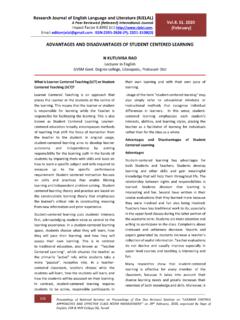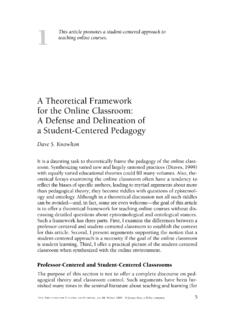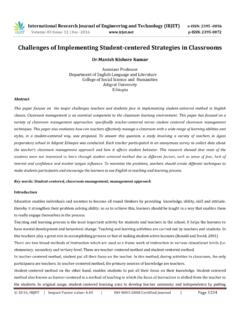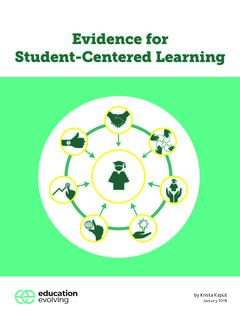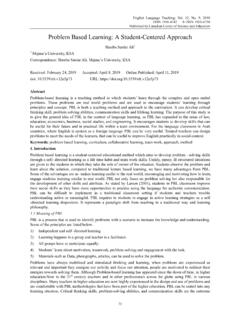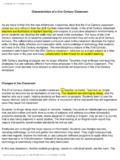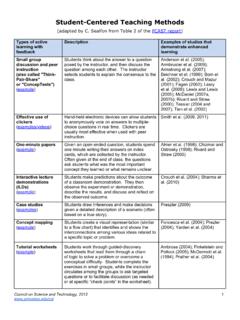Transcription of The Student-Centered Classroom
1 The Student-Centered ClassroomLeo Jonesc a m b r i d g e u n i v e r s i t y p r e s sCambridge, New York, Melbourne, Madrid, Cape Town, Singapore, S o PauloCambridge University Press32 Avenue of the Americas, New York, NY 10013-2473, Cambridge University Press 2007 This book is in copyright. Subject to statutory exceptionand to the provisions of relevant collective licensing agreements,no reproduction of any part may take place withoutthe written permission of Cambridge University published 2007 Printed in the United States of Americai s b n-13 978-0-521-95368-9 paperbackBook layout services: Page Designs International Table of Contents Introduction 1 1 Autonomous learning 2 2 Classroom Management 4 3 Motivation 13 4 Fluency and Accuracy 18 5 Teacher as Facilitator 25 6 Different Kinds of Activities 28 Conclusions 40 Further reading 41 IntroductionSome students say:J Why do we have to do pair work and group work?
2 J When I speak English, I feel stupid because I make lots of mistakes and don t know enough vocabulary. J I don t want to speak English until my English is much better. J I don t want to listen to other students speaking incorrect English because I ll learn their mistakes. J My teachers speak the best English. I want to learn from them. This booklet will respond to those don t want our students to become people who:J Can t communicate in the real worldJ Panic when they can t think of the right words to useJ Are tongue-tied because they re worried about making mistakes and losing faceJ Can t survive without a teacher to help them and guide themJ Look away in embarrassment when someone asks, Can anyone here speak English? A Student-Centered approach helps students to develop a can-do attitude. It is effective, motivating, and enjoyable. This booklet sets out to discuss how this approach can be implemented.
3 It also deals with the problems that may the following chapters, unless otherwise specified, we means we teachers and working together means working together in pairs or groups. Introduction 12 The Student-Centered Classroom 1 Autonomous LearningWorking togetherIn a Student-Centered class, students don t depend on their teacher all the time, waiting for instructions, words of approval, correction, advice, or praise. They don t ignore each other, but look at each other and communicate with each other. They value each other s contributions; they cooperate, learn from each other, and help each other. When in difficulty or in doubt, they do ask the teacher for help or advice but only after they have tried to solve the problem among themselves. The emphasis is on working together, in pairs, in groups, and as a whole class. Their teacher helps them to develop their language Student-Centered Classroom isn t a place where the students decide what they want to learn and what they want to do.
4 It s a place where we con-sider the needs of the students , as a group and as individuals, and encourage them to participate in the learning process all the time. The teacher s role is more that of a facilitator (see Chapter 6) than instructor; the students are active participants in the learning process. The teacher (and the textbook) help to guide the students , manage their activities, and direct their learning . Being a teacher means helping people to learn and, in a Student-Centered class, the teacher is a member of the class as a participant in the learning a Student-Centered class, at different times, students may be work-ing alone, in pairs, or in groups:J Working alone, preparing ideas or making notes before a discussion, doing a listening task, doing a short written assignment, or doing grammar or vocabulary exercisesJ Working together in pairs or groups, comparing and discussing their answers, or reading and reacting to one another s written work and suggesting improvementsJ Working together in discussions or in role-plays, sharing ideas, opinions, and experiencesJ Interacting with the teacher and the whole class, asking questions or brainstorming ideasAlso in a Student-Centered class, students may be teacher-led.
5 J Before students work together, their teacher will help them prepare to work together with explanations and pronunciation learning 3J While students are working together, their teacher will be available to give advice and After they ve finished working together, and the class is reassembled, their teacher will give them feedback, offer suggestions and advice, make corrections, and answer students are working together in English, theyJ Talk moreJ Share their ideasJ Learn from each otherJ Are more involvedJ Feel more secure and less anxiousJ Use English in a meaningful, realistic wayJ Enjoy using English to communicateBut some of them mayJ Feel nervous, embarrassed, or tongue-tiedJ Speak English and make a lot of mistakesJ Speak in their native language, not in EnglishJ Not enjoy working togetherIn the following chapters, we ll look at these problems and ways of dealing with The Student-Centered Classroom 2 Classroom ManagementLarge classesThe ideal size for a Student-Centered language class is probably 12!
6 (The num-ber 12 can be divided into 6 pairs, or 4 groups of 3, or 3 groups of 4, or 2 groups of 6 and 12 students can easily hear one another in a whole-class activ-ity.) But, of course, we can t choose the number of students in our classes. Most classes are larger, many classes are far larger. Is there a maximum size beyond which Student-Centered learning is inappropriate?Actually, the larger the class, the more necessary it is to have a Student-Centered class. The only way to give all the students time to speak is by having them work together. The difference between a large class and a smaller class is the amount of time we have to monitor the groups. With, say, 30 students we can usually get around to all the groups in a lesson, and spend a few moments listening to each group and making notes. With a very large class this isn t fea-sible, so we should keep track of which groups we didn t listen to in one lesson, so that in the next lesson we can give them our a crowded Classroom , we may not even be able to reach some stu-dents as we circulate.
7 We may need to rearrange the students and where they sit. (See Seating on page 8.) It s also important for students to sit close together so that they can talk softly and still hear one another. A lot of students talking loudly make a lot of noise! (See Noisy classes on page 11.)J Keep track of which groups you listen to so no one gets left Rearrange groups to be near enough for you to overhear as you walk Seat students close together so they can talk softly and still hear one small classesHow should students in a very small class work together? Should we take part in discussions as an equal partner? In a small class, students tend to be more teacher-dependent, waiting for praise or encouragement while they s hard to monitor a conversation and participate in an activity at the same time. It may be better to sit outside the group while students work together, and not be part of the group.
8 Nodding encouragement, showing Classroom Management 5interest, and answering questions are fine, but constant intervention isn t likely to encourage students to behave autonomously. We need to judge when it s helpful to add a comment or contribution, or when it s Avoid becoming part of the groups small classes tend to be overly Encourage students and answer their questions as you move from group to classesIn many ways, every class is a mixed-ability class. Even students who have stud-ied together all the time will have varied mastery of the language or remember different things. Some will be better at different skills: reading, writing, listen-ing, or speaking. They bring their own personalities, strengths, weaknesses, and learning styles to the don t want our better students to be held up by the weaker ones, or the weaker ones to feel intimidated by the better ones. We may need to arrange pairs and groups differently for different kinds of activities, sometimes putting weaker and stronger students in different groups, sometimes mixing weaker and stronger students (in the hope the stronger ones will encourage and help the weaker ones), and sometimes giving students different tasks according to their strengths and weaknesses.
9 There are no hard and fast rules about what to do we make our decisions based on our knowledge of each class and the individuals within it. This can be hard to do in a very large class, particularly if it meets only once a week. We may have to just hope for the best when arranging groups. Mistakes are sure to happen: Weaker students may not be able to cope, and stronger students may get Vary the way you pair your students sometimes put weaker and stronger students together; sometimes group students with others of the same agesYounger, immature students may find working together gives them a chance to misbehave when not supervised. Older students may fear losing face by mak-ing mistakes and lack the confidence to express themselves in less than perfect English. They may also have preconceptions about the right way to learn. students may need training in the methods used in a Student-Centered Classroom . If we re going to ask them to work together, we need to explain why this is desirable and how they can benefit from this and why the alternative 6 The Student-Centered Classroomteacher-focused lesson isn t as effective.
10 We can t assume that students will share our beliefs and try to impose those beliefs on them. Some younger students may need stricter handling. students who are unused to autonomy may need to be introduced to new methods Explain to students the benefits of group work and why the teacher-focused alternative isn t as Introduce methods gradually for more experienced students who are unused to classesIn a multilingual English class, where all students do not share a common native language, students are unlikely to speak in their native language provided that pairs or groups are arranged in such a way that each group is multilingual. (But we may need to separate inconsiderate same-language students who don t speak English together.) In a monolingual class, students may be more tempted to speak in their common native language rather than in English when working together in pairs or need to persuade students that they will benefit from speaking English in their English class, which may be their only chance to speak English.
